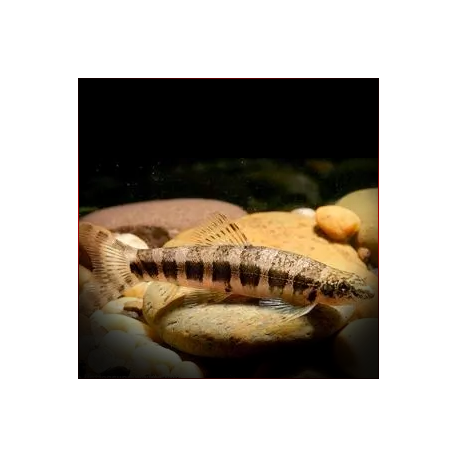More info
Datasheet
| Minimum Tank Size | 90 litres / 23.78 US gallons |
| Maximum Size | 5.0cm / 1.97inches |
| Temperature | 26°C / 78.80°F - 26°C / 78.80°F |
| Hardness | 2.02dgH / 36ppm - 10.03dgH / 179ppm |
| pH | 6.0-7.0 |
General Description
Fish sold under the name Serpenticobitis zonata are sporadically available in the aquarium trade but mostly seem to be the congener S. octozona. The genus comprises three members known only from the Mekong basin. S. octozona, the type species, is distinguished by its body patterning, featuring 8-9 pale, thin bars on each flank against a dark-colored body. S. cingulata displays 7-12 thin, dark bars that do not fully extend over a pale body. S. zonata showcases a pale body with 7-8 regular, dark vertical bars and thin, dark median bars in some specimens. The genus's genetic placement was initially unclear, notable for traits resembling both Nemacheilidae and Cobitidae families. Notably, in 2012, Serpenticobitidae was introduced as a distinct family with Serpenticobitis as the solitary member, characterized by specific body features and swim bladder structure.
Aquarium Setup
Maintaining S. zonata is not complex, but it thrives better in tanks mimicking flowing streams or rivers. Utilize substrates of variously-sized rocks, fine gravel, and sand, complemented by driftwood for a natural appearance. While most aquatic plants may struggle, robust varieties like Micropterus, Bolbitis, or Anubias spp. can be attached to the décor. Although extreme water flow isn't necessary, high dissolved oxygen levels and moderate water movement are beneficial. Employ external filters, powerheads, and air stones as required to ensure pristine water conditions, as organic pollutants accumulation can be detrimental. Regular 30-50% weekly water changes are advisable.
Behaviour
S. zonata is best housed with similar fish species that inhabit open water biotopes, with a preference for conspecific groups. Peaceful in nature, maintaining a group of four or more individuals is recommended to enhance their confidence. Other suitable tankmates include balitorids like Gastromyzon, Pseudogastromyzon, and certain Pethia, 'Puntius', and Rasbora species, fostering a harmonious tank environment.
Feeding and Diet
Being omnivorous, S. zonata's diet primarily comprises small insects, worms, crustaceans, and zooplankton, with minimal plant matter consumption. In captivity, they accept dried foods but require a varied diet for optimal coloration and health. Offer a mix of small live and frozen options such as Daphnia, Artemia, and bloodworms alongside dried food to meet their nutritional needs.
Reproduction & Dimorphism
Reproduction of S. zonata remains unknown in aquarium settings, and sexual dimorphism is unreported. Further research is required to understand their breeding behaviors and potential distinguishing characteristics between males and females.
Habitat and Distribution
Endemic to the Xe Bangfai and Xe Bang Hiang river drainages in Laos, within the middle Mekong basin, S. zonata is also found in the southeastern province of Chanthaburi, Thailand. Inhabiting shallow, fast-flowing, oxygen-rich headwaters and tributaries with rocky substrates and minimal aquatic vegetation, these fish thrive in clear, well-oxygenated waters with abundant biofilm. In the Khao Soi Dao Wildlife Sanctuary in Thailand, they coexist with various fish species amid unique environmental conditions.

